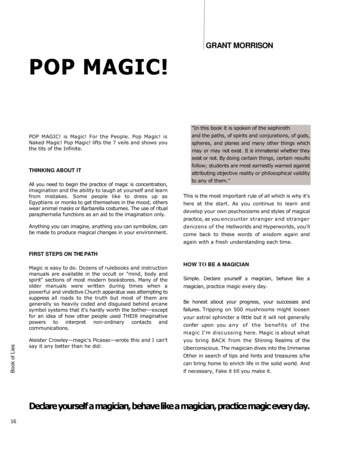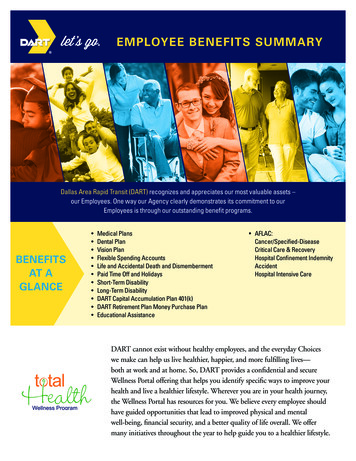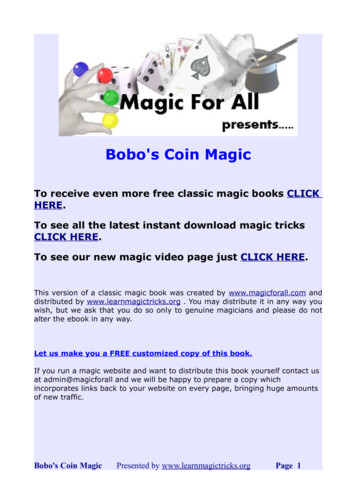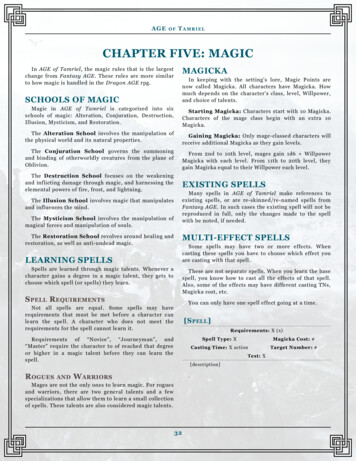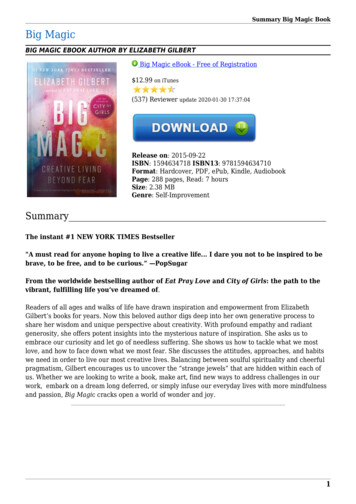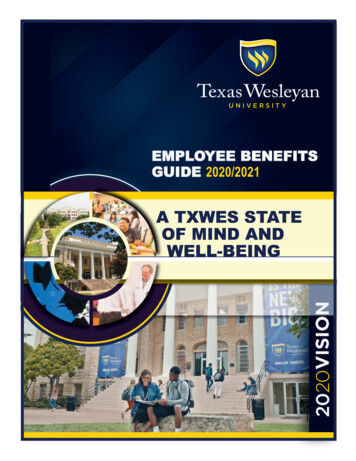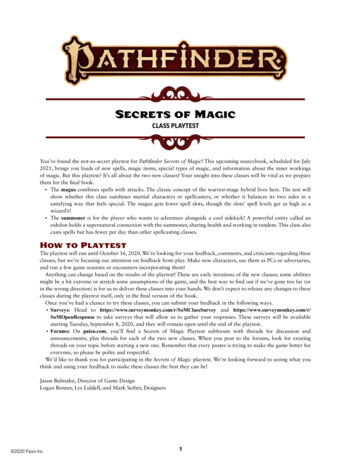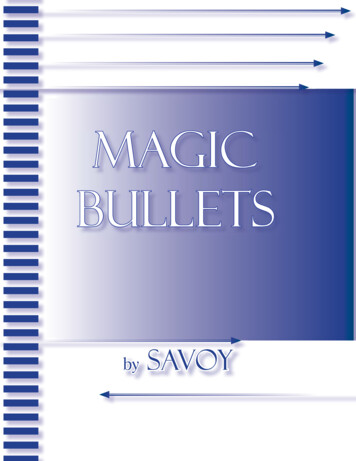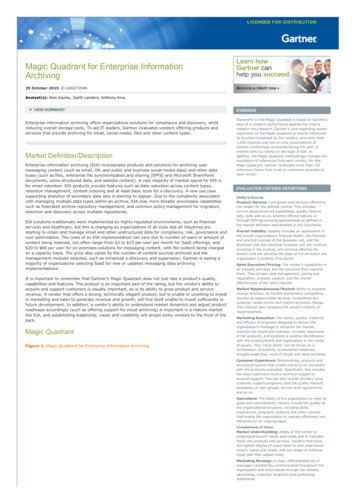
Transcription
5 Magic Steps toEmployee RecognitionProgram SuccessInnovative ideas to take your program from zero to hero
Table of Contents3Introduction4Set Your Employee Recognition Strategy9Decide on the Details14Build Your Employee Recognition Program21Shine a Spotlight on Your Plan25Measure Your ROI33Conclusion
IntroductionHi,I’m Debra Corey, a Reward Gateway Advisor,and I’ve launched employee recognitionprograms at a variety of companies of allsizes and in many different industries overthe course of my career. It’s becoming moreand more clear that employee recognition isno longer a “nice-to-have,” but a “must have”in organizations who are looking to engagetheir workforce and embed their companyvalues in new and exciting ways. Butwhere to start? Choosing the right kind ofmoments of recognition is so important toshow that you’ve been listening to what youremployees want, need and enjoy receiving.3 IntroductionThis eBook will walk you through thesteps needed to launch a top-notchemployee recognition program, including: How to define your employeerecognition strategy. How to make key recognitiondesign decisions. How to shine a light on yourprogram to increase engagement. Effective ways to measure the successof your programs and how to thinkabout recognition more strategically. Names and examples of employeerecognition programs.We’ll look at some of the things I’ve seenat Reward Gateway, as well as thingsI’ve done throughout my career at otherorganizations. Now, let’s get started Debra CoreyReward Gateway Advisor
Set Your EmployeeRecognitionStrategy4 Set Your Employee Recognition Strategy
Start with “Why”No matter what you’re creating, whetherit’s an employee benefits initiative, asoil, evaluate the sunlight, and create a planby determining what you’re trying to achieve.new learning platform or a top-notchrecognition program, you should alwaysstart your planning by defining your “why.”Likewise, for your recognition program, yourstarting point should always be to create astrategy based on exactly what you wantto “grow.” Here are some of the top reasonscompanies put recognition programs in place:As Simon Sinek, author of “Start WithWhy,” says, “When you start with ‘why’in everything that you do, you inspireaction in a way that ‘what’ doesn’t.”The key to this is asking yourself: Why amI launching a recognition program, andwhat do I really want to achieve with it?Whenever you’re building something, youwant to build with purpose. For instance, ifyou want to grow a garden, you wouldn’tjust plant a bunch of random flowers intothe ground, would you? You’d research the5 Set Your Employee Recognition Strategy1. Create a positive work environment.2. Create a culture of recognition.3. Motivate high performance.4. Reinforce certain behaviors.So ask yourself, what am I trying to achieveand why? Discover this answer before youmove on, so you wind up with a beautifulgarden, and not just a field of weeds!
Does your organization needemployee recognition?I believe that every company, no matterwhat size or what industry it’s in, needssome kind of recognition program. Thegood news is that it doesn’t have to beexpensive. I once saw a company usesimple Post-its as a way to recognizetheir workforce, but it does have to be apriority — 82% of employees surveyedby Gallup say praise and recognition areleading factors in helping them improvetheir job performance. If you don’t have arecognition program, ask yourself, can mycompany afford not to have 82% of myworkforce not at their peak performance?How you design your recognition programwill depend on your organization’s culture,values, business goals and the areas you’retrying to improve. I’ve seen companies look6 Set Your Employee Recognition Strategyinto building recognition programs for manyreasons, including some of these challenges: Little to no knowledge of anorganization’s purpose, mission or values. Low morale. Negative view of company culture. Low overall engagement score. An increase in unproductive employees. Little to no collaboration amongteams or individual team members.By building a program with purpose, you’llhave a better chance of addressing thesechallenges and introducing positive changesto both your people and your business.Did you know 50% of employees surveyed wouldleave a company if they weren’t regularlythanked and recognized for their efforts.(Source: Reward Gateway survey, 2017)Peer-to-peer recognition is 36% morelikely to have a positive impact on financialresults than manager-only recognition.(Source: SHRM)54% of employees feel their bosscould do more to appreciate them.(Source: Reward Gateway survey, 2017)Learn more at rg.co/thankyou
Create your recognition principlesGreat, you’ve answered the critical “why”question, but sorry to say that this doesn’tmean you can or should move on todesigning your recognition program. Atleast, not just yet. You’ve got one morething to do first, and that is to create yourrecognition principles. These help you defineyour program, what it stands for, whatmakes it unique and what it says to youremployees and the external marketplace.Finding the right principles will help youcreate recognition programs which trulydrive and support your “why,” aligning withyour company’s mission, culture and values.When designing your principles, I alwayssuggest to start with your mission andvalues to ensure that your principles arestrengthening your overall company vision.7 Set Your Employee Recognition StrategyMissionValuesRecognitionPrinciples
Using Reward Gateway as an example, here’s how we’ve designed our mission, values and recognition principles to all fit and work together:Mission:Let’s make the world a better place to work.Values:Love your jobBe humanDelight yourcustomersWork hardOwn itPush theboundariesSpeak upThink globalRecognition Principles:FairnessBalanceWowEasyGive all employees theopportunity to recognizeand be recognized.Provide a range ofrecognition plansthat recognize valuesin different ways.Provide a recognitionprogram that delightsour employees.Make recognitionplans that are easy tounderstand and use.8 Set Your Employee Recognition Strategy
Decide onthe Details9 Decide on the Details
Now it’s time to roll up your sleevesand make the key decisions about yourprogram. These are the nitty gritty detailsthat answer the important questionsof “what,” “who” and “how.” It’s reallyimportant to list as many as possible tomake sure you’ve thought of everythingwell in advance. Here are some examples:What? How many different recognition planswill you have within your overall program(e.g. will you have one or create differentplans to drive different objectives)? What recognition award(s) will beused (e.g. gifts, experiences, cash,or something else entirely)? What will you name your programand individual plans, and how will thisalign with other HR programs?10 Decide on the DetailsWho? Who will be able to send recognition? Who will be able to receive recognition? Who will administer the program?How? What system(s) will you use tomanage the program effectively? What processes will you put in placeto ensure it runs smoothly? How and when will you measurethe success of the program? What training will be developed and rolledout to ensure the program is understood?These decisions will vary by company andby provider as all recognition programsare built differently. Company needs varyby size, industry, workforce and otherfactors, so it’s important to take thetime and think through these questionsbefore moving on to the next step.Whichever objectives and principles youselect, double-check that they align andsupport your business goals and HRstrategy. Finally, make sure you discussthese with your key decision makers andagree on them before you begin designingyour program, as you want to ensureeveryone has had a chance to contributeas well as set proper expectations.
Decide your “Say” and “Do”A key part of answering the question“what” is deciding what your recognitionprogram will “Say” and what it will “Do.”These are the actual moments ofrecognition that occur at times or eventswhen you believe you should recognizeyour employees. They could be basedon activities (e.g., joining the company,having a work anniversary or a birthday) orbased on actions (e.g., helping a customer,helping a team member or suggestinga new way of doing things), or both.11 Decide on the DetailsThe “Say”The “Do”is the message you want to convey toboth the employee being recognizedand the broader organization.is the tangible reward you wantto give to help recognize theemployee’s activity or action.Your “Say” could be.Your “Do” could be. “Congratulations!” eCards “We appreciate your hard work” Financial award “Thank you” Posting their photo on therecognition wall
Let’s put it together.Action or Activity12 Decide on the DetailsThe “Say”The “Do”A colleague is navigatinga challenging conversationand demonstrating companyvalues to overcome objections.Let them know whata great job they did inhandling conflict at work.Send them a values-basedeCard.An employee helps a customersolve a really tricky problem.Congratulate them openlyin the team huddle.The manager gives theemployee a monetary award.A team spends the entire nightworking together to organize alaunch party for the company.Let them know how much youappreciate their hard workand how much it will helpmake the launch a success.Treat the team to anight out on the town.
Continuous recognition helpsboost your “Say” and “Do”Of course, these examples are just the startof what your “Say” and “Do” approachmight include. You may be surprised tohear a “Say” is sufficient for many actionsor activities. Often we think we need to“Do” something in every situation, but inreality, employees appreciate the “Say”just as much, if not more, than the “Do.”The key here is to be sure you makeyour employees feel recognized andappreciated, creating happy memories atthe same time. The added benefit for yourorganization is that the employee’s happymemory and experience is now foreverconnected to your company, increasing youremployee’s overall positive perspective.By making your “Say” and “Do” moments morefrequent, you can make continuous recognitiona core part of your company culture.50% of employees surveyed would leave acompany if they weren’t regularly thankedand recognized for their effortsrg.co/thankyouAt Reward Gateway, our suite of continuous recognitiontools help you boost your number of “Say” and“Do” moments. These tools include peer-to-peereCards that can be customized to match your brandand other objectives, monetary awards that havea finite pot of money attached so you can figureout how to budget appropriately, and the abilityMatch your brand and other initiatives. At RewardGateway, we have an entire set of values-driveneCards that playfully reflect all our values.13 Decide on the Detailsto nominate others at your company for whateveraward or recognition action you feel is appropriate.
Build Your EmployeeRecognition Program14 Build Your Employee Recognition Program
Each organization has its own strategy,so building your employee recognitionprogram will similarly depend on avariety of factors including your size,demographic, budget, etc. Someprograms will be very straightforward,with one recognition plan, while othersmay have multiple recognition plans.The RecognitionPyramid approachThe next question you’re probably askingyourself is, “how do you decide howmany plans to include in your overallprogram?” An approach I’ve used in thepast is a recognition “pyramid,” whichis a simple model to visualize who yourrecognition program reaches within yourorganization. Here’s how to build one:15 Build Your Employee Recognition ProgramThe Recognition Pyramid approach
The bottom section of the pyramid, thewidest part, is for what I call “anyone” and“anytime” recognition, so it touches themost employees and happens the mostfrequently. Many companies use this forplans that recognize all employees, and acommon solution is peer-to-peer eCards(digital greeting cards you can send toanyone, at anytime). My colleagues atReward Gateway can customize them toembed your brand, values and messaging tomake recognition easy, and more frequent.16 Build Your Employee Recognition Program
The middle section (you can have morethan one!) of the pyramid is where youbegin narrowing or reducing the numberof employees who are recognized. Thisis often done as a way to highlight andrecognize those employees whose actionsand accomplishments have pushed theboundaries and/or they have gone aboveand beyond with their performance.For this section, there are two commonplans — manager awards and monthly/quarterly awards. An example of the latter iswhen we used to host quarterly “Thank You”awards, in which employees would nominatetheir peers, a selection panel would choosethe winners and then we’d announce themat all-staff business meetings.17 Build Your Employee Recognition Program
The top section, the narrowest sectionof the pyramid, is where your recognitionprogram awards the best of the best,recognizing exceptional performance. Themost common plans for this are employeeof the year programs or a CEO/leadershipaward.There is no right or wrong number of plans,however, I suggest concentrating on allthree kinds of tiers. If you focus only onthe top tier, you may be missing out onthe opportunity to recognize more of yourstaff and, ultimately, improve engagement.One other tip is to make sure each sectionof the pyramid is clearly defined as well ashow it differs from the others, or you riskconfusion, misuse and even disengagement.To learn more about the pyramid and how tobuild your own, visit rg.co/recopyramid forother examples.18 Build Your Employee Recognition Program
What’s in a name?One of the most important decisions youcan make is the name of your program.The name will determine your overall brandand theme of the recognition program,and, of course, this is the name youremployees will use over and over againas they engage with the program. Hereare a few tips I’ve picked up to make sureyour name will lead you to success:1. Create meaningby asking yourself if the name relates backto the program and if it’s something youremployees will engage with. For instance,one of the most popular names I’ve seenis “Star” because it immediately bringsup the image of someone standing inthe limelight for their achievements.19 Build Your Employee Recognition Program2. Make your name stand out4. Think beyond the “now”with an interesting (but easy to remember)word or phrase that will cut throughthe clutter of their inbox or otherannouncements, and will look fabulouson your engagement platform.by selecting a name that can stand thetest of time and be more evergreen.3. Keep the name simple5. Consider involvingemployees to help youname the programby making sure it can be easily pronouncedand understood. Also keep in mind thatnot all words mean the same thing inall places, so this is especially importantif you have a global workforce.by creating some extra buzz leadingup to the launch and give employeesa sense of ownership from the startby inviting individuals or teams tohelp come up with the name.
Adding MORE to your recognition programI’ve seen dozens of names over the years, but here are some that I findcan be easily relatable in organizations of all shapes and sizes:In the latest revamp of Reward Gateway’sown recognition program, we chose the nameRecognition Program NamesMORE! — Moments of Recognition Everyday.Make sure your employee recognition program name has impact. Examples include:Above &BeyondAccoladeAllStarsApplauseStand outStarThe acronym MORE! sums up what we’re tryingto do, give more recognition. The individualwords represent our aim to create recognitionInspireKudosShineSimplyThanksCheersThe ExtraMilemoments, which we believe are a key partof recognition, and to do it continually.The new recognition program includes:Peer-to-peer eCards:Peer-to-peer awards:High FiveYou RockManager awards:Game Changer20 Build Your Employee Recognition Program
Shine a Spotlighton Your Plan21 Shine a Spotlight on Your Plan
Now that you’ve developed your worldclass recognition program, it’s time toput the spotlight on recognition. Publicizeyour program with special spotlights thattell employees how great it is and how touse it, and add extra spotlights on thosewho are being recognized (if appropriatefor your organization). After all, they’vedone something worth recognizing, soget out there and shout about it!Here are a few particularly specialspotlights to get you thinking Launch withimpactAs the expression goes, “You only get onechance to make a first impression!” That’sdefinitely true when it comes to launchingyour recognition program — this will be your22 Shine a Spotlight on Your Planbiggest opportunity to show employees howengaging and exciting your program will be.To create some buzz, you could launchit with a fun video, create a teaser orcountdown campaign, go on a recognitionroadshow or do desk drops of brandedmaterial so it’s always on view. The biggerthe impact your recognition programhas from the start, the more it will beremembered and used throughoutyour company on an ongoing basis.Keep italiveYour recognition program, like all yourpeople initiatives, should never be a “setit and forget it” play. You need to keepyour program fresh, and a great way todo this is to shine a constant spotlighton it in new and different ways.Here are a couple ways to do that: Create a video montage of recognitionmoments. Post an interview with a recognitionrecipient. Run a value-of-the-month campaign toget employees talking and recognizingeach other based on the value. Create a competition to see who cansend or receive the most recognitionduring a period of time.You can even use a recognition leaderboardto encourage a little friendly competitionamong employees. Whatever you do,find ways to keep it fresh and alive atyour company.
GetsocialEverything we do these days is social,so why not consider adding a socialaspect to your recognition program?At Reward Gateway, we use what wecall the “Wow Wall,” which is part ofour employee recognition platform.The way it works is that every timea colleague receives an eCard, it’sautomatically showcased to the rest ofthe company (if they choose to), andemployees can like or comment onthe recognition gesture, similar to theinteractions on other social mediaplatforms. Employees love it, and it helpsus achieve the objectives of our program.23 Shine a Spotlight on Your PlanIncorporating features you see on socialmedia puts the spotlight on the personbeing recognized, giving your entireworkforce the opportunity to celebratetogether and it subtly encourages youremployees to recognize each other,as they’re constantly reminded thatyou have a recognition program.As your recognition program evolves, yourspotlights will as well. The most importantthing to remember is not to let it fade away,as you want recognition to remain a criticalpart of engaging your employees. Thatwon’t happen if no one knows about it!Go mobile with the Connect appIntroduce your people to an on-thego employee recognition app with asocial recognition wall and companyblogs right at their fingertips. Send,comment and react to eCards right fromthe app. Plus managers can deliver onthe-spot recognition, even during theirdaily commute!
SharemomentsAnother way to shine the spotlight on moments of recognitionis to share them via employee communications, and letemployees recognize their peers on the spot, all in one place.The Reward Gateway platform lets you share special momentswith everyone and then instantly send recognition to yourpeers. This also provides more opportunities for employeesto understand what’s going on, outside their day to day, withthe ability to comment, tag and even react with a thumbs up!24 Build Your Employee Recognition Program
MeasureYour ROI25 Measure Your ROI
As part of your process, I’m sure you’llspend time talking to your leadershipteam and part of that discussion willinevitably be measuring the ROI (returnon investment) on your program. Tosuccessfully do this, you need to pullfrom your original strategy and showthat your program has accomplishedthe goals you’ve set out to achieve,and how. If you’re working with aprospective provider, that provider maybe able to give you examples of howtheir product worked for others or datapoints that will help prove your ROI.Many companies paint this picture byreporting on changes in retention, profit,customer satisfaction and/or employeeengagement, showing how they’veincreased as an indirect result of theirrecognition program. These are commonbusiness ROIs, and ones that business26 Measure Your ROIleaders will easily relate to and understand.You may wish to measure other ROIsdirectly related to your recognitionprogram, such as the following:ProgramusageThis measures interaction with the programand individual plans. It could include thenumber of eCards sent, the number ofaward nominations made, the amountof clicks on recognition stories, etc.SocialactivityThis also measures interaction withthe program and plans, but is specificto social interaction. It could includethe number of likes or commentsemployees are receiving or giving.AnecdotesNever underestimate the power of a greatstory. Report specific stories and examplesthat highlight the value your program andplans are having with your workforce. Thesedemonstrate the value of investment (VOI),as you won’t have a hard measurement.The key here is to select the right picturebased on the right measurements, sothat your business leaders will see theconnection between your program andchanges in these measurements. Makesure to test these with your leaders beforemeasuring, so that you get it right from thestart and don’t spend time and resourcespreparing reports that serve no purpose.
The business impact of strategic recognitionBringing recognition into your employeeengagement efforts is a must — we’vefinally understood that, I hope! Thoughtfulrecognition is a powerful way to showappreciation, help employees learn fromeach other and help your team focuson “the wins.” When you get good atrecognizing those who do their jobwell or go above and beyond their role,employees benefit in many ways.Strategic recognition helps create theenvironment for more engagement becausepeople are getting what they crave.RespectPurposeRelationships27 Measure Your ROIHere’s how recognition ties into giving employees more Respect, Purpose and Relationshipsat work:“I was really working hard on that project and put in some extra timeFeel more respectedoutside of work. I’m really proud that my efforts were evident to othersand that they see the impact of what I do.”Can more clearlysee the purpose andimportance of theirwork“I was surprised to get recognized for how I handled that customerBuild betterrelationships withothers“It was so nice of Steve to notice the extra effort I gave in thatinteraction. I didn’t realize the customer was so connected in thecommunity. It means a lot to see how my actions might have a realimpact on how someone talks about our company!”meeting. I don’t work with him
How to define your employee recognition strategy. How to make key recognition design decisions. How to shine a light on your program to increase engagement. Effective ways to measure the success of your programs and how to think about recognition more strategically. Names and examples of employee recognition programs.
